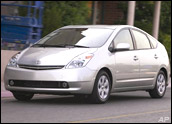
Google’s latest idea takes it off the information superhighway and onto the world’s real-life streets with it’s new RechargeIT initiative.
Promoted by its philanthropic arm, Google.org, the new initiative aims to reduce CO2 emissions, cut oil and gasoline use, and stabilize the electrical grid by accelerating the development and adoption of plug-in hybrid electric vehicles that are capable of selling stored electricity back to electric companies.
To get started, Google modified some of its vehicle fleet to plug into its own solar electricity power supply, as well as into any 120-volt power outlet.
Google’s Monster Garage
Current hybrid electric-gasoline cars offered on the mass market use the engine and brakes to generate electricity, which is then stored in batteries and used to help power the vehicle.
Google’s cars, on the other hand, have been specially modified with additional batteries and electrical adapters to let them charge and discharge electricity via plug-in electrical cords. Some companies, organizations and individuals have been able to modify existing hybrid cars to work this way, but they are few and far between.
The major key benefit for consumers of plug-in hybrids is the ability to run nearly entirely on electricity with the option of extended-range travel powered by gasoline.
The RechargeIT effort showcases the feasibility of plug-in technology, as well as gathers research data to help promote the industry, said Google.
73.6 Miles Per Gallon
Google has a fleet of Toyota Prius and Ford Escape hybrid vehicles and modified some of them with plug-in capabilities. The new Toyota Prius Plug-in now gets 73.6 miles per gallon of gasoline, while the original Prius gets 40.9.
Each of its cars, the company said, are outfitted with data recording devices that track technical and environmental performance, use patterns and charging history.
Back to the Grid
While plug-in cars aren’t a new concept, the idea of letting cars act as distributed storage batteries for electric companies is a radically new idea — to most consumers, at least.
Here’s how it works: Power plants produce electricity on demand. They don’t have good ways of storing electricity. Millions of batteries in hybrid cars could be utilized as a way to store energy for the power plants. Most cars are idle for 20 or so hours a day, and when energy is spread out over millions of cars, experts project, power plants could draw and store energy from parked cars, saving on greenhouse gas emissions and reducing the need for building new power plants. The concept is called vehicle-to-grid.
“Basically, I’ve been — for several years — getting plug-in hybrids out into the mainstream, so people stop thinking of them as a science project and realize how feasible they are now, and that’s really happening. We’ve succeeded in that,” Felix Kramer, founder of CalCars, told TechNewsWorld. CalCars is a nonprofit organization that promotes plug-in hybrid electric vehicles (PHEVs).
The Future Is (Almost) Here
“For a long time, I didn’t talk about vehicle-to-grid because it seemed too futuristic, and the case for hybrid cars could be made without it, but it turns out that companies and governments are starting to get serious about it. It’s now OK to talk about it — it’s now realistic. I used to think it was icing on the cake, but it’s this whole other desert,” Kramer explained.
Vehicle-to-grid is important because it may make it possible to more fully electrify transportation, which could displace gasoline, which tends to produce more greenhouse gases than other forms of generating power. In addition, an increased use of electricity could reduce demand on foreign oil.
Hot Afternoons
“In California, there’s only about 10 days a year when we have huge peak energy requirements, but the power grid is built and its capacity is defined for those ten days,” Kramer explained.
“If power companies had another way of getting out power, they could build fewer plants. They have what are called ‘peaker plants’ which only go on at times of maximum demand — and they’re not the cleanest plants,” he added. “Car batteries could provide energy during those hot afternoons.”
The result of air conditioners sucking electricity on hot afternoons in California, of course, in a vehicle-to-grid scenario, is that a PHEV could let the owner essentially sell its stored electricity back to the power company. However, the owner may then have to drive home under gasoline power.
So what if cars have to power home on gasoline 10 days out of the year? From an environmental perspective, “The net emissions benefit would still be very high,” Kramer noted.
Google As Catalyst
Google’s foray into the field may be the catalyst needed to kick PHEV technology and vehicle-to-grid efforts into high gear. The company is investing approximately US$10 million in technology and companies that will further PHEV and vehicle-to-grid development efforts.
“It’s quite inspiring because Google is creatively and smartly combining a lot of different things in this program. It’s demonstration, data collection and also a way of getting more players involved — more companies, investors, new businesses. They’re maximizing all those things,” Kramer said. “Google is showing what a company can do to motivate for not a lot of money.”




















































